On-premises IoT solutions provide greater control over data security and compliance by maintaining hardware and software within the organization's infrastructure. Cloud-based IoT platforms offer scalability and cost-efficiency, enabling real-time data analytics and seamless device management across multiple locations. Choosing between on-premises and cloud-based IoT depends on factors such as data sensitivity, budget constraints, and the need for rapid deployment.
Table of Comparison
| Feature | On-Premises IoT | Cloud-Based IoT |
|---|---|---|
| Deployment | Local data centers, owned infrastructure | Hosted on cloud providers (AWS, Azure, Google Cloud) |
| Scalability | Limited by physical hardware | Elastic, auto-scaling resources |
| Cost | High upfront capital expenditure | Operational expense, pay-as-you-go |
| Security | Full control over data security and privacy | Cloud provider security compliance (ISO 27001, GDPR) |
| Maintenance | Internal IT team responsible | Managed by cloud provider |
| Latency | Low latency due to proximity | Potential higher latency depending on internet |
| Integration | Custom integration with existing systems | Supports various APIs and third-party integrations |
| Data Control | Complete ownership and control | Data stored off-site with provider policies |
Understanding On-premises and Cloud-based IoT Solutions
On-premises IoT solutions offer direct control over hardware and data, ensuring enhanced security and low-latency processing suitable for sensitive industrial environments. Cloud-based IoT solutions provide scalable infrastructure, real-time data analytics, and seamless device integration, enabling rapid deployment and remote management across distributed networks. Choosing between on-premises and cloud-based IoT depends on specific requirements such as data sovereignty, operational costs, and scalability demands.
Key Differences Between On-premises and Cloud-based IoT Architectures
On-premises IoT architectures provide direct control over hardware and data security by hosting infrastructure locally within an organization's facilities, ideal for latency-sensitive and compliance-driven applications. Cloud-based IoT architectures offer scalable resources, seamless remote access, and advanced analytics capabilities by leveraging cloud service providers such as AWS IoT, Microsoft Azure IoT, and Google Cloud IoT. Key differences include deployment costs, maintenance responsibilities, data sovereignty, and flexibility in scaling, with cloud solutions favoring agility and on-premises systems prioritizing control and customization.
Security Considerations: On-premises vs Cloud-based IoT
On-premises IoT deployments offer enhanced data control and reduced exposure to external cyber threats by maintaining physical access and network isolation, critical for sensitive industrial applications. Cloud-based IoT solutions provide scalable security features such as real-time threat detection, automated patch management, and encryption managed by cloud service providers like AWS IoT or Azure IoT Hub, but increase reliance on internet connectivity and third-party trust. Evaluating IoT security requires balancing on-site infrastructure control against cloud provider capabilities in compliance standards like ISO 27001 and NIST frameworks.
Cost Comparison: Evaluating Expenses of On-premises and Cloud-based IoT
On-premises IoT solutions require significant upfront capital investments in hardware, infrastructure, and ongoing maintenance costs, often resulting in higher total cost of ownership (TCO) over time. Cloud-based IoT platforms operate on a pay-as-you-go model, reducing initial expenditures and scaling expenses based on data volume, device connections, and service usage. Cost efficiency depends on factors such as deployment scale, required customization, and operational management, with cloud solutions typically offering flexibility and cost savings for dynamic or large-scale IoT deployments.
Scalability and Flexibility in IoT Deployments
On-premises IoT deployments offer limited scalability due to fixed hardware resources, making rapid expansion challenging for growing networks. Cloud-based IoT platforms provide superior flexibility by enabling dynamic resource allocation and seamless integration with various devices and services. This scalability advantage allows organizations to efficiently manage fluctuating data loads and adapt to evolving IoT application demands without extensive infrastructure upgrades.
Data Ownership and Compliance in IoT Environments
On-premises IoT deployments provide complete data ownership and stringent control over compliance with regulatory standards, allowing organizations to tailor security measures and maintain data privacy within their own infrastructure. Cloud-based IoT solutions offer scalable storage and real-time analytics but may raise concerns about data jurisdiction, multi-tenant environments, and adherence to local data protection laws. Selecting between on-premises and cloud architectures requires careful evaluation of organizational compliance requirements, data sensitivity, and the legal frameworks governing IoT data management.
Performance and Latency: Which IoT Solution Leads?
On-premises IoT solutions offer superior performance and lower latency by processing data locally, minimizing transmission delays critical for real-time applications such as industrial automation and smart manufacturing. Cloud-based IoT platforms provide scalability and remote accessibility but may suffer from higher latency due to data traveling over the internet, impacting time-sensitive operations. Edge computing frameworks that blend on-premises processing with cloud analytics represent an optimal approach to balancing performance and latency in IoT deployments.
Integration Challenges and Opportunities
On-premises IoT solutions offer greater control over data security and customization but face integration challenges with legacy systems and limited scalability. Cloud-based IoT platforms provide seamless integration, real-time analytics, and flexible scaling, yet pose concerns about data privacy and reliance on network connectivity. Leveraging hybrid architectures can optimize both approaches, enhancing interoperability and operational efficiency in diverse IoT ecosystems.
Use Cases: When to Choose On-premises or Cloud-based IoT
On-premises IoT solutions are ideal for industries requiring low latency, stringent data privacy, and full control over sensitive information, such as manufacturing, healthcare, and critical infrastructure. Cloud-based IoT platforms excel in scalability, global accessibility, and advanced analytics, making them suitable for supply chain management, smart cities, and consumer IoT applications. Enterprises prioritizing real-time processing and regulatory compliance often choose on-premises, while those emphasizing rapid deployment and integration prefer cloud-based IoT systems.
Future Trends in On-premises and Cloud-based IoT Solutions
Future trends in on-premises IoT solutions emphasize enhanced edge computing capabilities, enabling real-time data processing and improved security by keeping sensitive information within local networks. Cloud-based IoT solutions will increasingly leverage AI-driven analytics and scalable infrastructure to support massive device connectivity and sophisticated data insights. Hybrid models combining on-premises control with cloud scalability are emerging as a dominant approach to balance latency, privacy, and operational efficiency in IoT deployments.
On-premises vs Cloud-based Infographic

 techiny.com
techiny.com